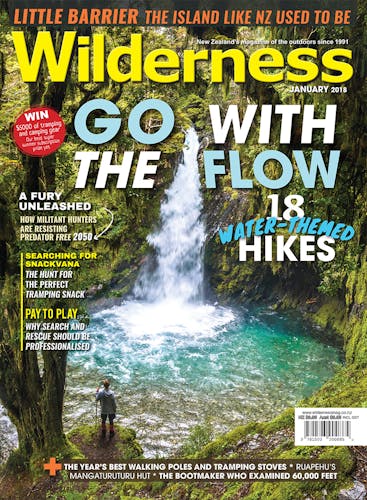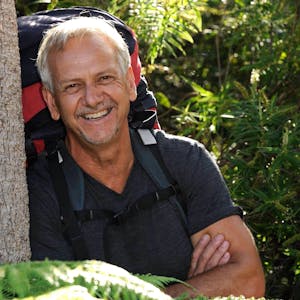Some hunters regard Predator Free 2050 as the thin end of a wedge that will see the Government come after their deer. A militant few are taking matters into their own hands.
In October, someone released sika deer into north Taranaki forest. In an anonymous letter – signed, it claimed, on behalf of six Taranaki hunters – they told the Department of Conservation they had loosed ‘at least 30’ into the formerly deer-free block in reprisal for the department’s use of 1080. They threatened that more would follow until DOC stopped using the poison.
Ordinarily, DOC keeps schtum about such ‘liberations’ – renegades are easily kindled to copycat – but this time, director-general Lou Sanson went public. A DOC staffer’s vehicle had just had a window smashed in. Weeks before, a wheel flew off a contractor’s vehicle after the nuts had been undone. Checks revealed two other vehicles had been sabotaged. That, on top of an incident in which someone left 1080 baits in a DOC employee’s letterbox.
Then, in early December, DOC received another letter, claiming more deer liberations and promising: ‘a war like no other…’. The writer warned that ‘these hunters have more guns than you or the police. We are going to bring you bastards to your knees. We will take down helicopters who support 1080 drops. We will take down people one by one, blood will fall. Watch this happen’.
Something is rotten in the state of Aotearoa. In July, 2016, then-conservation minister Maggie Barry proclaimed New Zealand’s “moonshot” project: Predator-Free 2050, the orchestrated doom of the country’s possums, rats and stoats. Every last one. A year later, she wrote in praise about the national subscription to that cause: “There’s been an extraordinary surge of enthusiasm from New Zealanders for Predator Free – with thousands of volunteers in Wellington alone.”
But north Taranaki is not Wellington. Nor is the West Coast, where DOC workers and their families routinely suffer abuse, intimidation and threats. Nor is the Coromandel, where staff and community conservation leaders have been assaulted.
Any weeknight, you can visit anti-1080 Facebook pages and read florid, serial diatribes about DOC, about the wider Government, and about Predator Free 2050, which many plainly consider to be nothing less than an attack on their way of life. PF 2050 is quite specific: it’s only about possums, rats and stoats, but some have skipped straight to some imagined last page of a manifesto they plainly believe is coming after their deer, too. There are repeated references to Agenda 21, a UN sustainable development initiative born out of the 1992 Earth Summit, but lately whipped up into a conspiracy theory that governments everywhere are trying to steal people’s property rights and force them to urbanise.
This sort of rhetoric finds a ready readership in anti-1080 circles: ‘They are deliberately killing off everything that’s edible in the bush so we cannot hunt it…’ charges one member of Facebook page 1080 Eyewitness; ‘It’s about the new world order, take the water, kill off all the wild food … and make all self-sufficient on the supermarkets where all the foods are poisoned!’
If this sort of thing sounds far-fetched to you, perhaps that only highlights the growing gulf between urban values and rural New Zealand. DOC’s traditional silence over illegal game releases meant that the north Taranaki incident came as a shock to many, but it wasn’t news: illegal releases have been a costly fact of local governance for years. By 2001, contract shooters had already removed 323 deer from 20 different spots around Taranaki in the space of just four years. Sika were let go into Russell Forest, in Northland in 1987. Northland rate- and taxpayers shelled out $200,000 for the Animal Health Board and Northland Regional Council (NRC) to clean them up and test them all for bovine TB. The council had already dealt with 74 deer at 18 other Northland sites when, around six years ago, someone released another mob back into Russell Forest.
Such insurgence is usually justified by claim of entitlement, or even ‘birthright’: ‘It’s not DOC’s land, it’s ours and we want to hunt,’ blustered a poster on Facebook page Stop 1080 Now after the north Taranaki release.
Taranaki iwi might disagree. Ngāti Tama are tangata whenua and kaitiaki of Parininihi forest, not far from the release site. The tribe has tackled pests in the block for the last five years, clearing it for the reintroduction of kokako last July – an historic return after the birds were exiled back in 1999. DOC has supported that effort with three aerial 1080 operations in north Taranaki since August. “Those forests are in really good nick,” said Sanson, “and sika are devastating on our plant species … if they get established, it would have a big impact in Taranaki.”
He pilloried the hunters for “sabotaging community conservation projects that are working towards Predator Free 2050.”
Appealing to any sense of community, says Northland Regional Council biosecurity manager Don McKenzie, is probably a waste of time. “As far as we’re concerned, these greedy recreational hunters can go somewhere else.” He points out that the north has more community conservation groups than any other region by far, “and I’m confident that if you ask those communities what they want, they would tell you that, having grafted for 15 years to get pest numbers down, the last thing they want is more pest animals on their patch.”
Which is why the council’s proposed new deer plan, drafted to deal with both illegal releases and farm escapes, is enjoying broad support, but the only thing that will deter hardcore hunters, says McKenzie, is the certain knowledge that all their efforts will come to naught: “Rules are one thing: but prosecutions are difficult to get. We know that the very best deterrent is to have a special response team. We employ paid professionals whose sole job is to eradicate deer, week in, week out.” Forget the image of the old Government deer culler in a Swandri, stopping to roll a smoke – McKenzie’s squad use the latest in military technology – like thermal imaging – to hold deer numbers in Northland down to the “ones and twos. We still have low numbers of deer in Russell Forest, Mangakahia and Maramanui, near Dargaville.”

Illegal releases of sika hamper conservation work and stock movement on farms. Photo: Malcolm Lock, DOC
It’s not cheap – the new plan will cost $200,000 a year to run – but, says McKenzie, “It’s the only deterrent. The fact that there are still no deer populations established in any of our forests is a testament to that.”
DOC’s own capacity to mop up illegal releases has been hobbled by budget cuts. It used to have an ungulate control team of its own in Taranaki, but it was disbanded. The Deerstalkers Association and the Game Animal Council have offered to take up the slack: “We have access to some extremely capable and talented hunters, particularly of sika deer,” says council chairman Don Hammond. “I’ve contacted the Central North Island Sika Foundation … and asked them to contact all of their members, request that they kill any of the released sika deer they encounter, and provide any assistance to the police and DOC to identify the people who released the deer. We ask the whole hunting community to do the same.” At the time of writing, eight sika had been shot at the Taranaki site.
Preventing – or at least monitoring – this covert game industry was one job of the shadowy Wildlife Enforcement Group (WEG). Comprised of DOC, MPI and Customs officers, WEG was also responsible for holding up New Zealand’s end of the CITES agreement – the Convention on International Trade in Endangered Species. But the unit was disbanded in 2014 without explanation or announcement after 22 years and 24 successful prosecutions. In August this year, DOC launched a new compliance strategy that covers illegal releases, along with other transgressions like poaching in marine reserves, timber theft, wildlife smuggling and whitebaiting breaches. The plan will rely on nine full-time compliance staff and volunteers – ‘honorary warranted officers’ – to make it stick.
There is nothing to suggest that illegal game releases will stop anytime soon. In fact, we might only expect them to proliferate as hardcore hunters tool up for what some plainly regard as a battle for the backcountry. Anti-conservation rhetoric is ramping up, mostly from militants promulgating the myth that Predator Free 2050 is Government deer culling in drag: a blogger on the New Zealand Hunting and Shooting forums expresses dismay at ‘New Zealand’s attempt to lead the world in a systematic programme of species eradication. Our extremists … are going for the lot, it’s going to be a clean sweep. It is truly an eco-fundamentalist campaign of such sweeping magnitude, it would make Adolf Hitler look like a timorous wimp’.
False premises like this are polarising values around Aotearoa’s forests, and social media will keep the flames fanned. They will almost certainly incite more subversive releases, which, ironically, may finally galvanise New Zealanders to decide what they want the bush to be – a haven for indigenous biodiversity, or a hunter’s theme park.
“We need to let the public have their say on those areas of the country they want to see deer free,” says Don McKenzie. “We’re not saying we should remove deer from the country altogether. We want to keep deer out of Northland, and we would suggest there are other regions that feel the same way. I think we’ve got to draw a line in the sand somewhere about this.”
Alien sightings
Many European settlers came to New Zealand to escape the injustice of the British class system, which granted aristocracy exclusive rights to game like deer and salmon, leaving the working class to pick over rabbits and ‘coarse fish’. A founding tenet of the new colony – endorsed by successive parliaments – was that New Zealand would be stocked as a vast, egalitarian game park.
In the bush, at least, and along the riverbanks, all men would be equal. This proxy constitution was enacted with such zeal that, before the turn of last century, 54 species of mammals had been brought here from all over the globe and set loose. Thirty-two of them established (33 if you believe moose still roam Fiordland).
By 1910, farmers and foresters were already complaining about the ravages of deer, right about the time trampers and hunters began to notice a change in the forests, too. The first ‘Deer Menace’ conference was held in Christchurch in 1930, attended by Internal Affairs, the Forest Service, Forest & Bird, various regional acclimatisation societies and the Wildlife Branch of Internal Affairs. The status of deer flipped abruptly from hallowed to hated. The Government began hiring deer cullers.
The Wild Animal Control Act, introduced in 1977, forbids any further liberations, and carries penalties – a maximum two-year prison term, a fine of up to $100,000, or both – for those that defy it. But clearly, many still consider the few remaining corners of deer-free Aotearoa as unfinished business. A 2004 Landcare Research study found nearly 100 novel deer populations around the country. They found new fallow deer herds in 11 of the then-13 DOC conservancies, with 12 new herds in Whanganui alone.
In 2009, sika deer turned up at Toatoa in the eastern Bay of Plenty, far from any known population. That region is free of bovine TB, so cattle farmers faced the prospect of stock movement restrictions. The deer were released not far from a forest restoration project and covenant managed by local iwi. DOC hired a hunter, who shot two animals within days, but it was suspected that more had been released. Sika have also been found in the Marlborough Sounds, and at Port Waikato.
These are almost certainly the tip of the antler.








